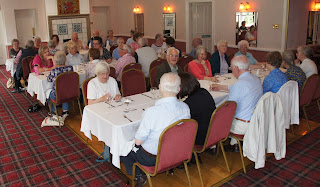On Saturday 2nd June at 1.00 pm, 33 members and guests of the Society began the journey, by coach, to the Royal Burgh of Dunfermline, travelling en route along the M9 past the Kelpies and over the Queensferry Crossing into the Kingdom of Fife. The first stop was at the Carnegie Library and Galleries which was recognised in 2017 with the Royal Incorporation of Architects in Scotland Andrew Doolan Best Building in Scotland Award. We were welcomed, provided with maps and invited to find our way around this new facility and encouraged to spot some of the special highlights among the display of historic rare objects including a time line of 700 years of Scotland's Kings and Queens, the Meldrum Loom, the Dunfermline Gala Day painting and a cast of King Robert the Bruce’s skull.
With the weather remaining good, it was easy to appreciate from the top floors of the building the associated beautiful gardens, the sculptures of Tam O' Shanter and Souter Johnny and the magnificent views of the Abbey Church, all of which form part of Dunfermline's Heritage Quarter within easy walking distance of the Carnegie Library and Galleries. The Abbey Church was a particular attraction in part because of its royal associations but also because one's eyes were quickly drawn to the top of its tower by the large lettering of King Robert the Bruce. Time was spent inside the Abbey Church with helpful guides admiring the Tomb of King Robert, the carved pulpit and lectern, the Royal Pew and the beautiful stained glass windows. Thereafter, a short walk took one to the site of the Palace and the Pittencreiff Park but unfortunately time was limited and it was not possible to explore them fully before the group was required to walk the short distance to the Andrew Carnegie Birthplace Museum, the second principal stop of the day.
 |
| The Carnegie Birthplace Museum, Dunfermline. (© I.S.Ruddock) |
At the Museum we were welcomed by the curator and divided into groups to facilitate visits to the home and the associated museum. We learned that the Carnegie story (1835-1919) began in mid-19th century Dunfermline where his father was a handloom weaver of linen in the family home that comprised a single room with box beds on one side and cooking on an open fire. Times were hard and so the family decided to emigrate to North America where Andrew Carnegie (AC) started out as a bobbin boy and later a telegraph operator. Thereafter, with 'inside knowledge of the market' and financial help from his mother, the entrepreneurial skills of AC rapidly developed with involvement in railways, transport and communications. He then amassed a fortune in the steel industry and in the early 1900s sold the Pittsburgh Carnegie Steel Company for $480M becoming the richest American for the next few years. AC then devoted the remainder of his life to large scale philanthropy with particular emphasis on local libraries, world peace, education and scientific research. He was sometimes referred to as the Scottish-American millionaire socialist.
 |
| The curator (right) describing what can be seen in the main part of the Carnegie Birthplace Museum. (© I.S.Ruddock) |
A great afternoon was completed with dinner at the Elgin Hotel, Charlestown. Fife with magnificent views overlooking the Firth of Forth and its bridges. Apparently the hotel has links to Thomas Bruce (1766-1841), 7th Earl of Elgin and 11th Earl of Kincardine, nobleman, politician and diplomat known primarily for the removal of marble sculptures from the Parthenon in Athens, some small replicas of which could be seen in the hotel. Dinner was followed by the journey back to Kirkintilloch past Longannet power station and over the Kincardine Bridge. Votes of thanks were given after a most successful half day’s outing to some of Scotland's historic heritage.


